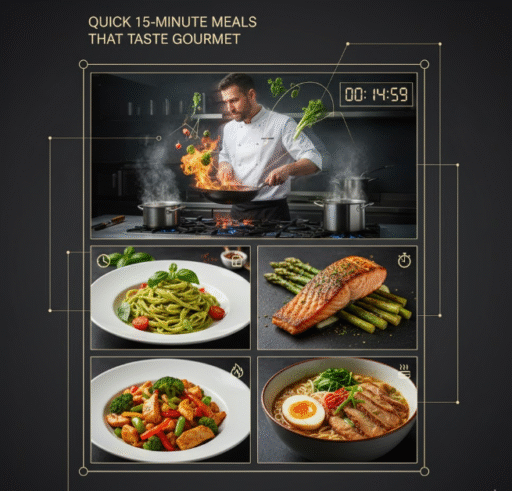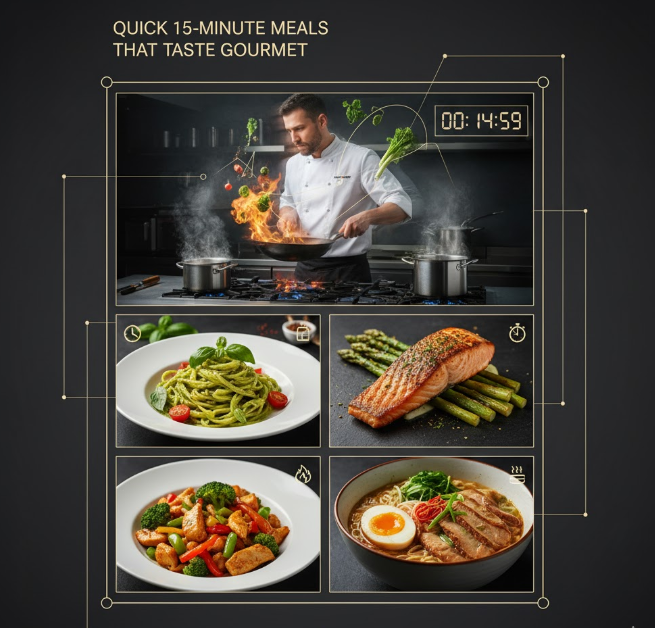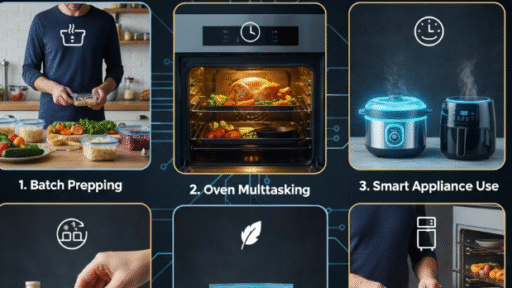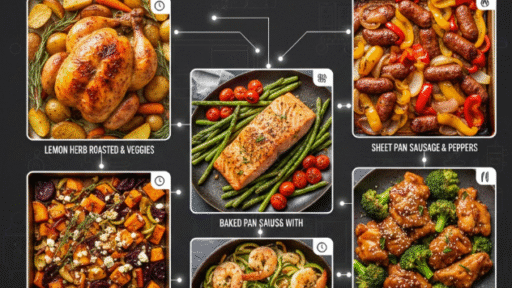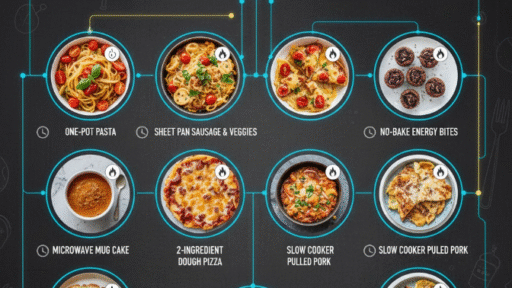Garlic sizzles from the pan on your stove. A perfectly cooked piece of salmon gives off a waft of steam. A living sauce streaks across your plate in swirling loops. This is not the product of cooking for hours or a degree from culinary school. When you know the keys to whipping up a gourmet-quality meal in fifteen minutes.
The majority of folks think that fancy food means investing a long time and difficult techniques. They believe that restaurant-quality would-be menu items should not be made at home but rather only in a professional kitchen, by a chef with training, and using expensive equipment. This misconception is what holds so many home cooks hostage to a menu of dull, repetitious dishes. The reality is that gourmet cooking is not so much about time, but knowing which ingredients complement each other, mastering a few basic cooking techniques and having some clever shortcuts up your sleeve.
In today’s fast-paced world, it isn’t practical for many of us to spend hours in the kitchen. Work, family obligations and personal demands can make finding even a half-hour to cook feel impossible. But everyone deserves to eat something wonderful, restaurant quality and special. The good news is that you definitely can prepare impressive meals in a fraction of the time you might assume it would take. And these fast gourmet meals will elevate your weeknight dinners from average to outstanding and do so quickly — less time than some sitcoms.
Why Speed and Quality Are Really the Same Thing
The wisdom of the ages tells us that it’s worth taking your time in the kitchen. Although this is certainly the case sometimes, such as with slow-braised meats or breads fermented overnight, this doesn’t apply to everything. A lot of gourmet practices actually cook the food more quickly than standard techniques. And high heat searing produces a gorgeous crust in minutes. The most vibrant, best ingredients require barely any prep work to be shown off. It’s as if some sort of fancy sauce enters your kitchen, but the concoction is just a humble pan sauce.
For decades, the restaurant industry has been in on these secrets. Restaurants are places where speed and productivity are paramount. Chefs cook as much in advance and use good ingredients that have to be processed less. They know which flavors go together naturally, and which cooking methods will deliver the best results with the least effort. Take these same principles to your home kitchen and suddenly your fifteen-minute meals taste like they’re fresh off the menu of a well-appointed bistro.
The benefit of this fast cook time is that your ingredients will stay fresher and not be as soggy! When cooked for a short time, vegetables tell their story in brilliant color and just the right texture. Sure, fish remains moist and tender in undercooked dishes. Herbs and tender greens don’t lose their bright flavors when tossed with just-cooked pasta at the last minute. These attributes are the hallmarks of gourmet food, and they tend to occur naturally when you cook quickly.
Speeding Up Your Kitchen
Before we get into recipes, you’ll want the right setup. A well-run kitchen minimizes the time you spend cooking. As long as the tool is easy to get to, locate your most-used tools. Place spices that you use regularly near the stove. Keep a good knife sharp and ready. These little things are what can make the difference between a harried five minutes and a relaxed and successful cooking experience.
The tools you need for gourmet cooking in a pinch are basic — like a heavy-bottomed skillet, sharp chef’s knife, microplane grater for citrus and cheese and tongs. You don’t need expensive gadgets or special equipment. These things cover 90% of anything you need to cook fast. A good skillet will aim to distribute heat evenly so hot spots that burn your food are nonexistent. With a sharp knife, prep work is faster and safer. Tongs allow you to turn over and rearrange food in the pan without fumbling with more than one utensil.
You should have on hand, in your pantry, some specific ingredients with which to flavor whatever you cook. So you want some good olive oil, real butter, whole cloves of fresh garlic, great salt and whole peppercorns. Throw in some capers, olives and canned anchovies or sun-dried tomatoes, really good Parmesan cheese and you never have to worry about bold, gourmet flavors again. These are the ingredients that can make ordinary proteins and vegetables into unforgettable meals. They store for months, so you’re never not prepared to make something awesome.
So do using fresh ingredients, but you don’t need to hunt down the most esoteric ones. Lemons, fresh herbs like parsley and basil, shallots and cherry tomatoes are good to have around. These little fresh elements illuminate dishes and give them that restaurant profundity. A hit of lemon juice can transform an entire meal. Sprinkled over a finished dish, fresh herbs provide aesthetic appeal and aromatic layers of complexity. These are the touches that make people think you spent a lot more time cooking than you actually did.
Protein Perfection in Minutes
Protein is usually the slowest to cook, but some cuts and types cook surprisingly quickly. Thin-slice chicken breasts, shrimp, scallops and fish fillets all cook in less than 10 minutes. The very first decision you’ll make when going for a quick-cooking stir-fry is picking your protein.
Shrimp may well be the quickest gourmet protein available. Large shrimp take around three minutes to sear per side. When seared correctly, they develop a beautiful golden color and go with virtually any flavor combination. For a Mediterranean-inspired Italian dish, cook shrimp with olive oil and garlic, then add wine and lemon juice and some butter and fresh parsley. It should take no more than eight minutes but will taste as if you have ordered it from a restaurant on a coast.
Salmon fillets with crispy skin are another gourmet option. Start with fish at room temperature, pat it completely dry, season with salt, then sear skin side down in an oiled hot pan. Use a spatula to press gently on top for the first 30 seconds to make sure it doesn’t curl. Sear on one side for four minutes, then flip for one minute. It will be perfectly cooked with gourmet crispy skin, and if you serve it on arugula with lemon vinaigrette, you need only twelve minutes.
Thin-cut pork chops or sliced chicken is cooked identically quickly. The trick is to pound them to even thickness so that they cook uniformly. Then simply season with salt and pepper and fry three minutes per side in butter. Remove from the pan and use a splash of wine or stock to deglaze the flavorful browned bits. Then add a spoon of butter and herbs and pour the sauce over your protein. You can cook any thin-cut meat that way. Indeed, the taste depth shouldn’t be possible in that amount of time.
Veggies Are the Stars of These Dishes
We all know that vegetables, while they can be wonderful, don’t get much love. Properly cooked, they can be the focal point of a gourmet meal, rather than merely an afterthought. Fast and furious cooking techniques help preserve that inherent sweetness, while the varied textures can make things interesting.
It may sound slow for a fifteen-minute meal, roasting something in the oven, but the truth is, little vegetables or thin pieces can roast at top heat fairly quickly. Cherry tomatoes burst and caramelize in ten minutes at 450 degrees. The thin spears of asparagus roast in eight minutes. Cut them in half, and a dozen minutes later golden edges will be crisped on the halved Brussels sprouts. These vegetables are tossed with a good drizzle of olive oil and salt before roasting, then simply finished off with a balsamic reduction and some shaved parmesan for instant flair.
Sautéing offers even faster results. Green beans cook in five minutes if thrown into a hot pan with some oil. Finish with toasted almonds, lemon zest and butter for classic French preparation. Zucchini slices take three minutes to cook and are delightful with mint and feta cheese. What separates the good sautéed vegetables from the “meh” ones is cutting them into pieces roughly the same size, and not stuffing in more than will fit comfortably in your pan at one time. Let them have the room to brown rather than steam and they will develop the caramelized edges that make vegetables irresistible.
Quick gourmet meals should also consider raw vegetable preparations. A very basic salad of arugula with shaved fennel, orange segments and toasted pistachios takes no time to toss together but tastes and looks sophisticated. Peppery arugula plays opposite sweet orange; fennel contributes notes of anise and crunch. Dress it with a simple vinaigrette of fresh-squeezed lemon juice, olive oil and a little honey.
Pasta Dishes That Impress
Pasta is the ultimate quick meal, but so many of us get in a rut adding jar sauce and missing out on really easy gourmet variations. Fresh, or thin dried pastas take only a few minutes to cook and there’s no shame in making smooth sauces from scratch.
Aglio e olio, or garlic and oil pasta, is ridiculously easy, but also mind-blowingly good when done well. Cook the thin spaghetti according to package directions. Slice garlic thinly and cook in plenty of olive oil until just golden. Add red pepper flakes, then pour in the drained pasta along with a ladleful of pasta cooking water, fresh parsley and lemon zest. The starchy pasta water emulsifies with the oil to form a creamy, silken sauce that clings to every slick strand. This classic, four-ingredient Italian dish takes 10 minutes in all and tastes infinitely more complicated than it is.
There is also carbonara — another fast dish, but one that requires an eye to the technique. Whisk together eggs, grated parmesan and black pepper while pasta cooks. Sauté diced bacon or pancetta until crisp. As soon as pasta is al dente, drain it and toss it immediately with the bacon fat while the pan is off the heat. Add the egg mixture and stir vigorously, allowing the residual heat to gently cook the eggs without scrambling them. The end result is a creamy, sumptuous sauce that doesn’t need a drop of cream. Throw in the crisply cooked bacon pieces and some more cheese on top, and you are back to restaurant-quality carbonara in thirteen minutes.
On the lighter side, a lemon butter sauce with fresh herbs and vegetables makes a perfect pasta topping. Boil angel hair pasta as you cook cherry tomatoes and cut asparagus in butter. Add fresh basil, lemon juice and zest at the end. Toss everything together with the pasta and a little cooking water. The bright, fresh flavors of the dish are perfect for spring and summer eating, and it all comes together more quickly than delivery would arrive.
Building Flavor Quickly
The key to a gourmet-tasting 15-minute meal is all in the efficient layering of flavors. Cooks add complexity by bringing corresponding flavors together along with at least two different strategies for building complex flavor quickly.
Browning is the result of the Maillard reaction, in which proteins and sugars meet under high heat to produce hundreds of new flavor compounds. This is why roast meat has more flavor satisfactions than boiled meat. You can apply this principle to fast-cooking dishes by making sure that you cook over high heat and allow some color to develop. Take your time browning, even if you’re short on it. Two minutes of proper searing packs a lot more flavor than all the seasoning in the world.
Acids lift the brightness of food and intensify other flavors. A squeeze of lemon juice, a bit of vinegar or a spoonful of capers delivers immediate complexity. Acids have another richness neutralizer, so lemon frequently appears next to butter in your repertoire of classic dishes. Make a point to include an acidic ingredient in your dish and it will transform from something ho-hum to restaurant quality before your eyes.
Finishers such as these could turn a good dish into a great one. A drizzle of great olive oil, a handful of fresh herbs, a few shaves of good cheese and/or a sprinkling of toasted nuts all contribute texture as much as flavor and visual appeal. They need no cooking time and yet pack a huge wallop. Have them at the ready for every dish you cook.
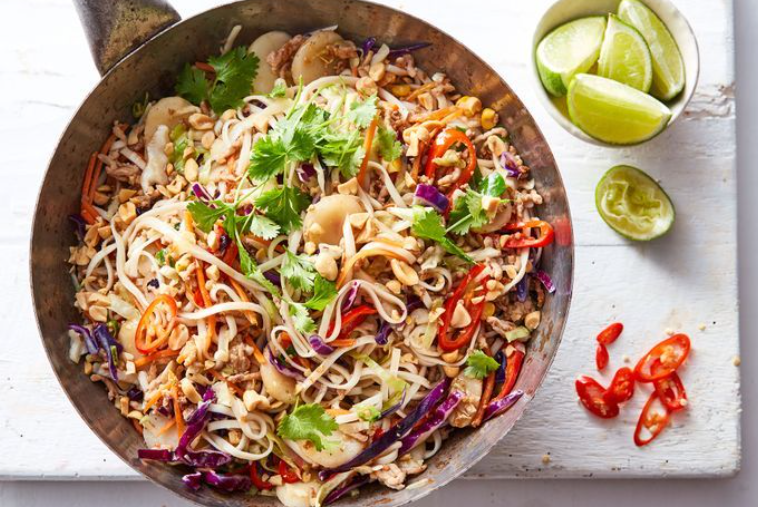
Complete Fifteen-Minute Meal Ideas
Pan Fried Scallops with Pea Puree and Crumbled Prosciutto
Dry large sea scallops thoroughly and season with salt. Place a stainless steel or cast iron pan on the stove and heat it until very hot. Drizzle in a neutral oil and gently place scallops into the pan to ensure there is room between them. Cook without disturbing, 2 1/2 minutes or until golden crust forms. Flip, and cook 2 minutes. Meanwhile, puree frozen peas with chicken stock, butter, lemon juice and salt until smooth. Bake or microwave prosciutto until thin and crispy. Spoon pea purée on to plates, pile scallops on top and garnish with prosciutto shards and microgreens. This classy dish seems as if it should come from a fancy dinner menu, but in reality takes thirteen minutes.
Thai-Inspired Coconut Curry Shrimp
Add oil to a pan and then sauté the minced ginger and garlic for 30 seconds. Stir in the red curry paste and cook for 30 seconds, until it starts to be aromatic. Add coconut milk and fish sauce, then simmer. Add large shrimp to pot and cook until pink, about four minutes. Squeeze in lime juice, Thai basil and thinly sliced red chilies. Serve over quick-cooking jasmine rice or rice noodles that you can make in the same time frame. And the interplay of coconut, curry and lime yields rich, balanced flavors that somehow taste as though they’ve been simmering for hours.
Balsamic Chicken with Caprese Salad
Pound chicken breasts to uniform thickness and season with salt and pepper. Sauté in olive oil 4 minutes per side. Remove chicken and pour balsamic vinegar into the hot pan, reducing it down to a thick syrup. Meanwhile, thinly slice tomatoes and fresh mozzarella. Put them on plates with fresh basil leaves, drizzle with some olive oil and sprinkle with salt. Add chicken to the side of the salad and drizzle with balsamic glaze. This complete meal balances warm and cool elements perfectly.
Miso-Glazed Cod with Sesame Vegetables
Whisk together white miso paste, mirin, a little sugar and rice vinegar. Brush over cod fillets and broil 6 minutes. While fish cooks, stir-fry snap peas and bell peppers in sesame oil for three minutes. Add soy sauce and sprinkle with toasted sesame seeds and green onions. The sweet and salty miso glaze caramelizes while the fish is in the broiler, yielding restaurant-level results with minimal effort.
Steak With Herb Butter And Roasted Tomatoes
By the way, look for thin sirloin steaks or minute steaks — something that will cook fast. Season it liberally with salt and pepper. Sear, in a ripping hot cast-iron pan, for two minutes on each side if you want it medium-rare. Allow to rest as you roast halved cherry tomatoes, tossed with oil at high heat for 8 minutes. Combine softened butter with minced garlic, fresh parsley and lemon zest. Spoon a pat of this compound butter over the rested steak and serve with the roasted tomatoes. The butter melts into the warm steak, forming a hit-the-pan sauce.
Quick Meal Components Comparison
| Component | Cooking Time | Difficulty Level | Versatility | Impressive Factor |
|---|---|---|---|---|
| Seared Scallops | 5 minutes | Medium | High | Very High |
| Shrimp | 6 minutes | Easy | Very High | High |
| Thin Fish Fillets | 6–8 minutes | Easy | High | High |
| Thin-Cut Chicken | 8 minutes | Easy | Very High | Medium |
| Quick Pasta | 10–12 minutes | Easy | Very High | Medium-High |
| Sautéed Vegetables | 5–7 minutes | Easy | Very High | Medium |
| Pan Sauces | 3 minutes | Medium | Very High | High |
| Fresh Salads | 5 minutes | Easy | High | Medium |
Common Mistakes to Avoid
Even when you’re cooking a simple recipe, there are mistakes to avoid that can trip up your fast gourmet meals. Knowing these traps will help you steer clear of them and become consistently successful.
That is probably the single most common mistake. When too many ingredients are layered around the cooking surface, they steam and don’t brown. And steam is wet, which means we don’t develop any caramelization — the stuff that gives us flavor. Never crowd items in the pan. If you have to cook in batches, do that rather than crowding everything together.
Wasting time and not preheating well enough is very bad for results. A cold pan heats up slowly and unevenly, which means food will stick and cook unevenly. Preheat the pan, then add oil; preheat oil before adding ingredients. You’ll be able to tell that the pan is ready because a drop of water will sizzle and instantly evaporate. It’s an easy step that will save your scallops from sticking and allow it to brown nicely.
And over or under do it and you diminish your results. Salt enhances the flavor of ingredients, but excessive salt suppresses flavor. Get into the habit of tasting as you cook and adjusting seasoning little by little. Reminder: Salty elements, such as parmesan, capers and anchovy work on the base layer of overall saltiness. And keep in mind that pasta cooking water is supposed to be “salty like the sea,” if it is to season pasta from within.
Without accounting for carryover cooking you end up with overcooked proteins. Meat keeps cooking once you take it off the heat. A few degrees higher in resting temperature of the inside contents. Proteins that are perfect (or even better, just a little looser than you’d like) should be cooked to this point of slightly earlier doneness. This step is crucial when you’re dealing with quick-cooking things like shrimp and thin fish fillets, which are ready the second they hit their doneness mark and then overdone less than a minute later.
Making It Look Restaurant-Worthy
Presentation is more important than many home cooks know. The same meal can seem quotidian or special, depending on your presentation. The good news is, basic plating methods are easy to learn and don’t take long to master.
Start with clean plates. If any drips or splatters, wipe them off before serving. This easy extra is what elevates your food from amateur to professional immediately. Whenever you can, use white or another neutral for plates; they show food off more effectively than busy patterns.
Consider height and composition. Instead of laying everything flat on the plate, layer components to build dimension. Layer protein over vegetables or grains. Lean elements against each other. This leads to more visual interest and denser looking parts.
When setting out items, use odd numbers. Three scallops are better than two or four. Five pieces of asparagus look better than four or six. This borrowed principle of art and design makes food for some reason more appealing.
Garnish thoughtfully. A pop of color and a final polish comes from fresh herbs, microgreens, edible flowers or a strategic drizzle of sauce. But proceed with caution — a little bit of the proper garnish is much, much better than a mountain of gratuitous ones. The garnish should serve as a reference point to the dish’s flavors, not merely an afterthought that sits around the edges.
Adapting Recipes to Your Preferences
The thing that’s nice about knowing speed-gourmet skills is that you can always improvise. Once you understand the fundamental principles, you can switch proteins; change vegetables and adjust flavors to suit your palate and dietary requirements.
If the recipe calls for chicken and you prefer fish, be aware of cooking times and make adjustments accordingly. Fish takes less time to cook than chicken, to avoid overcooking shorten the cooking duration. If you’re vegetarian, substitute proteins with robust vegetables, tofu or beans made using the same steps. Cauliflower steaks sear up beautifully and present a party-ready vegetarian main course.
Sauce variations offer endless possibilities. A simple pan sauce template, deglaze with wine or stock, reduce, add butter and herbs — is open-ended enough to work with just about any flavor combination you can dream up. For beef, use red wine and rosemary; for chicken, white wine and tarragon; for fish, vermouth and dill. And once you’ve mastered this one technique, you can make dozens of different gourmet sauces.
Your dietary restrictions should not leave you with nothing to eat. A lot of quick gourmet dishes happen to align with different diets. Your standard grilled proteins plus vegetable sides are fine, whether you follow paleo, keto, whole-30 or whatever. Many an Italian-inspired dish lends itself to gluten-free pasta. This is a generalization i.e. meals inspired from Asia don’t generally use dairy at all. Concentrate on fresh, whole, recipes with simple preparation and most people can easily eat your meals.
Time-Saving Prep Strategies
Though these meals take just fifteen minutes, a little bit of prep in advance can make them even simpler. Use these tactics for especially busy times.
Stock pre-washed salad greens and pre-cut vegetables for the busiest nights. Yes, doing it yourself is cheaper, though the convenience factor might be the difference between you cooking a nice meal and ordering takeout. Buy the things you will actually use, and don’t let perfect be the enemy of good enough.
Sometimes make parts of it ahead when you have the time. Combine your favorite spices and store in small jars. Make compound butters, freeze them in logs in parchment paper. Slice fresh ginger and garlic, then freeze them with olive oil. These little preparations save minutes of cooking time and don’t involve a lot of work.
When you actually do make grains and starches, cook extra. Rice, quinoa or pasta heat up fast and can form the base for several swift dishes. Leftover rice turns into fried rice in no time. You can throw extra pasta with different ingredients and have instant cold salads.
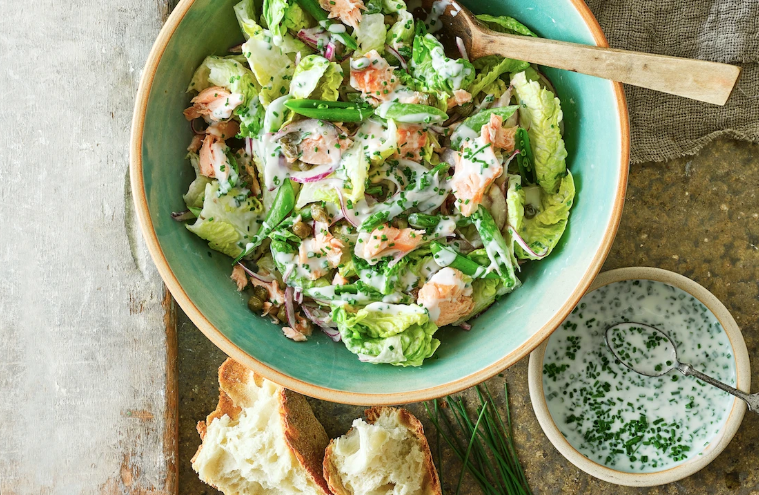
Frequently Asked Questions
Can one actually prepare gourmet meals in fifteen minutes?
Yes, especially when you concentrate on quality ingredients, quick-cooking proteins like shrimp or thin cut meats and simple but effective techniques like pan searing and fresh herb finishing. The secret is to select recipes tailored for the quick preparation rather than attempting to hurry dishes that really do require more time.
If I don’t have a certain ingredient in a recipe, what should I do?
Quick gourmet cooking is forgiving. Substitute similar ingredients freely. If a recipe asks for shallots and you only have regular onions, use those. No white wine? Use chicken stock with a dash of lemon juice. The idea is that you’re making delicious food, not following recipes to the letter.
Do I need expensive equipment?
No. A good knife, a heavy skillet and some everyday pots are almost all that’s needed to take care of the vast majority of quick cooking tasks. Quality matters more than quantity. It’s better to have one great pan than five bad ones.
How do I tell when proteins are cooked?
Visual cues are effective when dealing with fast-cooking proteins. Shrimp turn opaque and pink. Fish is flaky when pressed gently. The chicken or pork should be firm but slightly springy. For real certainty, use an instant-read thermometer. The chicken should be 165°F, the pork 145°F and the fish also at 145°F.
Can I meal prep these dishes?
Some elements hold up very well, but they are still best made just before eating. That said, you can prep components ahead of time — wash and dry protein, cut vegetables, measure spices — and cook fast as soon as it’s time to eat. This strategy leaves you with fresh, hot food and (relatively) few minutes of actual cooking.
Which wine goes with fast gourmet foods?
Match the wine’s weight to the richness of the dish. Enjoy with white wines like Sauvignon Blanc or Pinot Grigio and light fish dishes. Darker fish or chicken is fine with Chardonnay. Medium-bodied reds such as Merlot or Pinot Noir are good with red meat. Wine you just like to drink is always a good default — a matter of personal preference is the most important consideration.
How can I bulk up these meals?
Add quick-cooking starches or grains. Rice noodles cook in minutes. Couscous steams in five minutes. Crusty bread doesn’t need any cooking. When I’m in the mood for something more substantial, I add extra vegetables, which don’t add much cooking time but do create a much heartier meal.
Are these meals budget-friendly?
They can be. Shrimp and scallops are more expensive than chicken or pork, but even so, cooking at home will save you a lot of money over what you would pay in a restaurant. Prioritize seasonal vegetables; they are often cheaper and taste better. Quality isn’t always highest cost — a properly cooked “boring” chicken breast with fresh lemon and herbs can be more satisfying than a badly-cooked, super expensive ingredient.
The Joy of Bringing Gourmet Cooking into the Home
Quick gourmet cooking changes the way you think about weeknight dinners. Rather than treating dinner like one more thing to cross off your list, these methods let you prepare food that’s really good without compromising your night. The distinction between a ho-hum meal and gourmet can be the smallest things — correct seasoning, a squeeze of fresh lemon, some scant herbs, sliver thin garlic and allowing proteins time to brown.
Begin with one or two techniques that resonate. Sear proteins until you nail those deep golden crusts. Practice your pan sauce until it’s second nature. As such muscle memory is developed, add new ones to your arsenal. Soon, you’ll be cooking gourmet meals without recipes, throwing random ingredients together because you saw them displayed at the market and happened to have something similar already lying around.
The true triumph isn’t to eat better food. It’s the self-assurance that you can eat really well, all of the time. That knowledge alters your relationship with cooking. The act is no longer stressful; now it’s creative. You begin to anticipate testing new combinations and approaches. There will be a noticeable difference in the way friends and family perceive your cooking, and you’ll likely find yourself hosting dinner parties more regularly, because you know you can tackle anything on that invitee list.
Keep in mind that even chefs can’t learn their trade overnight. You learn something new about timing, seasoning and technique each time you cook. Give yourself time to learn this skill. Even the less-than-perfect results are nearly always good and instructive. The idea isn’t to be perfect — it’s not even, really, that you cook from-scratch meals every day of the week; it is merely that you create food you like to eat, and do so on a timeline that works for your life.
These gourmet fifteen-minute meals show that it doesn’t take long to cook something truly amazing. But with smart ingredient choices, sound technique, and a little practice, you can serve restaurant-quality fare any night of the week. Your kitchen becomes a place where good things happen fast, a place where after a long day at work you just want to come home and cook something different rather than settle for the fastest thing you can whip up. That’s the real magic of quick gourmet cooking — it turns every meal into a chance to get good food and have fun making it.

